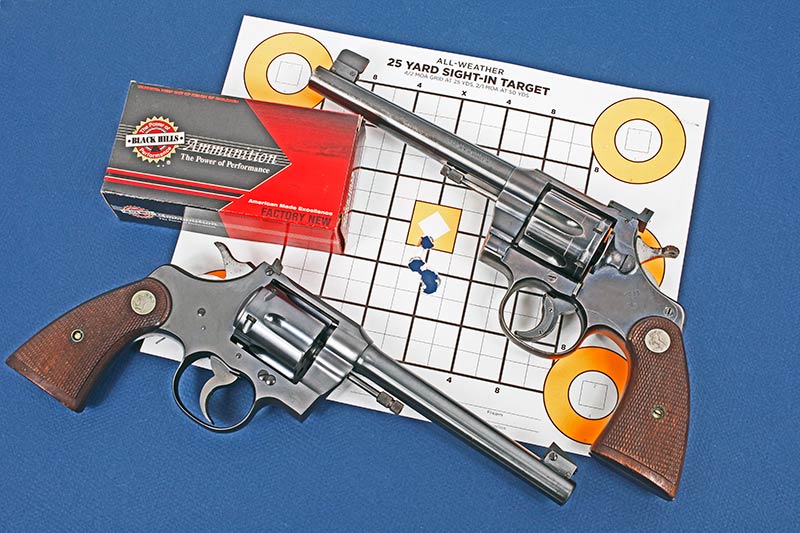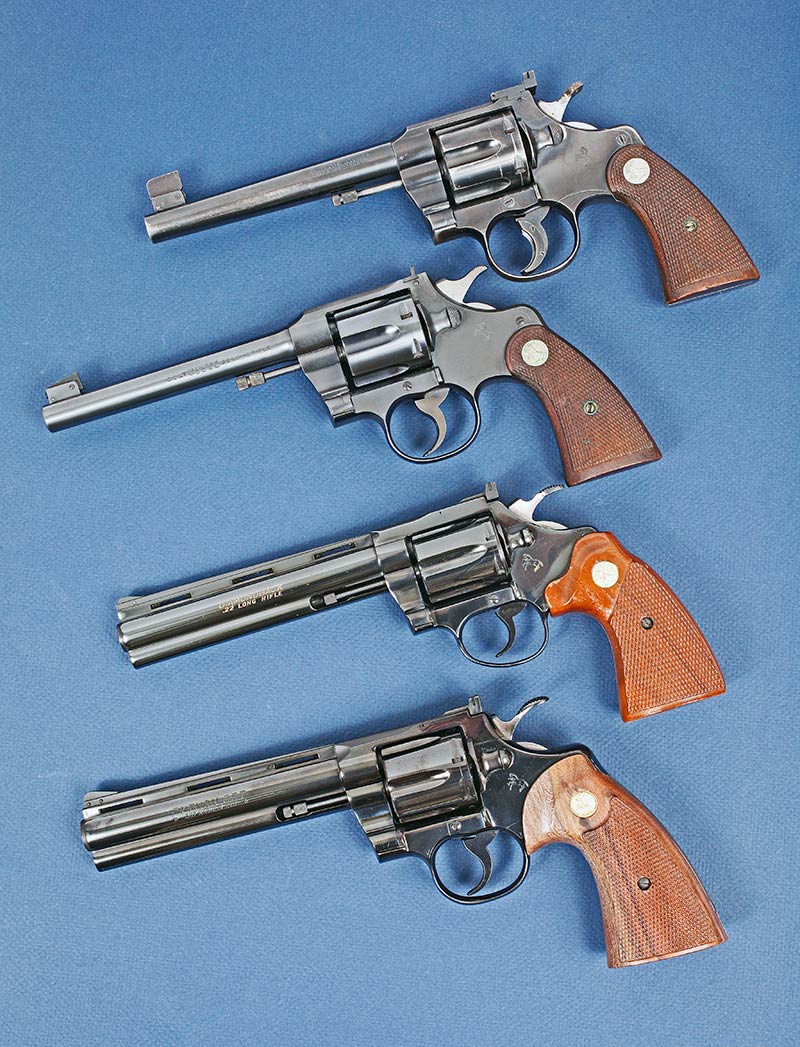I sort of stumbled onto this .38 Special Colt Officers Model a couple of years ago. I did a favor for a friend and he asked if I wanted “Something in a box or some money?” Knowing this friend, I said, “Something in a box.” I chose wisely, as they say. The “something” I received is, from what I can discover, a “Third Issue” Officer’s Model Target, Heavy Barrel. The serial number range shows it was made in 1937 and it’s in great condition, well-used, but it times right and looks good. This was a target shooter’s gun for sure and shows honestly worn grips and back-strap blue wear typical of the sort.
The interesting bits are the front and rear sight changes, trigger shoe and hammer mod. At first, I thought it might be the work of Kings, who was the go-to source for target revolver work in those heady days of fierce firing line competition. But Kings always stamped their work and there was nary a Kings mark on this gun.
The front sight base is stock, so I think whoever did the sights installed a higher front blade to match the period-correct Micro adjustable rear. The hammer mod is that classic King design called the “Cockeyed Hammer” spur. There’s a bit of welded-on metal to the left side of the spur, then it was checkered and drilled to lighten it. It made single action cocking faster and easier, which was what was done in those days.
The SA pull is a feathery 1 lb. 10 oz. while the DA pull seems pretty stock. Accuracy is amazing, and using standard high quality 148-gr. target wadcutters from Federal and Black Hills the gun shoots 1″ at 25 yards pretty easily if I use my “good” glasses. I’ve never fired anything else through it and don’t plan on it. This is timeless, old-school cool stuff and it’s fun to re-live the 1930s.
Another Score
Then, talk about great luck, I was nosing around on a good friend’s site where he sells some amazing classic guns (www.sportsmanslegacy.com) and stumbled onto another Officer’s. This one is a Colt Officer’s Model, but factory stock — and in .22 LR! A quick serial number check revealed it began life in 1938 so I’d call it a peer to the .38. An interesting side note is the SA trigger shows 3 lbs. 10 oz. and that’s about right for dead-stock.
There’s a bit of magic at work here too. I have a blued Python and a blued Diamond Back in .22, so how on earth could I not have the parents to my more “modern” guns at-hand too? My charge card was glowing for a short time.
Smarter people than me know way more about these guns, but from what I gleaned, Colt introduced the first of these “medium-framed” models in 1904, calling it the Officer’s Model, catering to police business. Between then and about 1969, Colt produced several variations, with slightly different mechanicals and looks, but all based on the same idea of a medium-framed gun good for target shooting and even police duty use.
The Officer’s Model Target was offered beginning in about 1927 and was chambered in .22 LR, .32 Colt and .38 Special. The heavy barrel (like my .38) was made optional in about 1935. According to one source, only the 6″ barrel was offered post-war. The grips were checkered walnut with silver-colored medallions so mine seem to be correct.
In those days target shooting was pretty mainstream and these models ruled the roost. Guys like Fitzgerald of Colt honed these actions to within an inch of their lives, helping to assure the guns shot as well as humanly possible with the technology available then. As times changed, model designations changed from “E” frames (with the firing pin in the hammer) to “I” frames if the firing pin was in the frame, but the quest for quality always remained.
Living History
These guns were considered at the top of Colt’s revolver lines during their production years, and from the glass-hard, smooth actions on mine, I can see why. The stunning Colt Royal Blue — especially on the .22 here — needs no introduction. Yeah, I know, today’s guns are cheaper, “better” built, easier to make, offer more design options and run the gamut from simple to complex.
But when talented labor was cheap and hand-work the norm, the Officer’s Models were artistic mechanical marvels. They didn’t “need” to polish them the way they did, nor take the time to apply that ocean-depth blue or tune the actions so finely it’s hard not to shed a tear when you press the trigger. But they did, and the only reason for it is the pride and satisfaction of doing something 100 percent right. Not 98, or even 99.9 — but 100 percent right.
Look at the photos of the early guns here and you’ll clearly see the legacy the Python, Diamondback and even the Trooper proudly wear. Once introduced in the middle 1950s, the Python stole the show from the Officer’s Model and grabbed the top-dog, “Super Premium” slot. And rightfully so. But still, like a classic fine car, elegance of build quality, old-school design touches and that difficult to define aura all hold sway. A Python is significant — but an Officer’s Model is like a vintage Bentley, still drawing looks and compliments from everyone wherever it “proceeds.”
I put these sorts of guns in the “Fewer But Finer” pile. I’ve been selling off the “commodity” or more common guns I simply don’t use any longer and reinvesting the money in “nicer” guns. It’s a nice change of pace and at a seasoned age, it’s great fun to be able to shoot guns I only dreamt about when I was younger. You should think about all this too.


